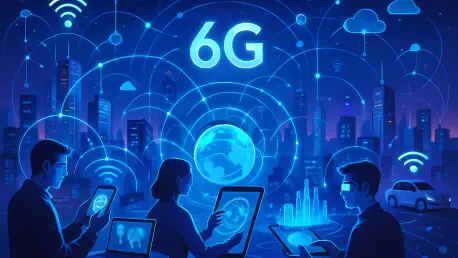Picture a future where internet speeds are thousands of times faster than anything experienced today, where a device in the most isolated corner of the planet connects effortlessly through satellite networks, and where artificial intelligence oversees entire communication systems with minimal human oversight. This vision is not a distant dream but the tangible promise of 6G technology, the next evolutionary step in cellular networks, poised to redefine how the world connects by 2030. Building on the advancements of 5G, this emerging technology is designed to deliver unprecedented performance while supporting the rapid expansion of smart cities, Internet of Things (IoT) devices, and cutting-edge applications. The journey toward this transformative era has already started, with global standardization efforts underway, driven by organizations like the International Telecommunication Union (ITU). As the world anticipates a hyper-connected future, 6G stands as a beacon of innovation, promising to bridge gaps and empower societies on an unimaginable scale.
The scale of ambition behind 6G is matched by the challenges ahead. With an estimated 40 billion IoT devices projected to be in use by 2030, the demand for robust, high-capacity networks has never been more pressing. This technology aims to meet those needs by leveraging new spectrum bands and integrating groundbreaking solutions to ensure seamless connectivity across every region. However, the path is not without obstacles, as regional differences in adoption strategies and past experiences with 5G shape a varied global landscape. Industry leaders are stepping up to address these complexities, focusing on innovations that will ease the transition and maximize impact. As the standardization process targets completion by the end of 2030, the excitement surrounding 6G continues to build, hinting at a world where technology integrates effortlessly into every facet of life, from urban hubs to remote outposts.
Performance Breakthroughs of 6G
Unmatched Speed and Latency
The defining hallmark of 6G technology lies in its staggering performance upgrades, setting it apart from even the most advanced 5G networks currently in operation. Capable of achieving speeds up to 1 Tbps—thousands of times faster than 5G—this next-generation network promises to revolutionize data transfer, making tasks that once took minutes complete in mere fractions of a second. Equally impressive is the ultra-low latency of just 1 microsecond, a dramatic improvement that ensures near-instantaneous communication. Such capabilities are not merely incremental but foundational for futuristic applications like 3D telepresence, where users can interact in real-time immersive environments, or critical monitoring systems that demand split-second responses. These advancements position 6G as a cornerstone for industries reliant on speed and precision, fundamentally altering how data-driven solutions are implemented across sectors.
Beyond the raw numbers, the implications of these performance metrics are profound for shaping digital experiences in the coming years. The ability to handle massive data loads at unprecedented speeds means that 6G can support the exponential growth of connected devices without sacrificing reliability. This is particularly vital for emerging technologies such as autonomous vehicles, which require flawless, real-time data exchange to ensure safety and efficiency. Additionally, the reduced latency opens doors to innovations in healthcare, like remote surgeries performed with robotic precision over vast distances. As standardization efforts progress toward 2030, these performance benchmarks are not just goals but essential drivers that will enable a seamless integration of technology into daily life, pushing the boundaries of what is possible in a connected world.
Powering Future Innovations
The performance breakthroughs of 6G extend beyond speed and latency to enable a new wave of transformative innovations across multiple domains. Smart cities, for instance, stand to benefit immensely, as 6G can process vast streams of real-time data to optimize traffic flow, energy usage, and public safety systems with unparalleled efficiency. This level of connectivity ensures that urban environments become more responsive to the needs of their inhabitants, reducing waste and enhancing quality of life. Moreover, the technology’s capacity to manage high-density device networks makes it ideal for supporting the intricate ecosystems of IoT applications, from smart homes to industrial automation. This ability to sustain complex, data-intensive operations marks 6G as a pivotal force in driving societal advancements.
Equally significant is how these performance gains lay the groundwork for redefining global communication paradigms by 2030. The sheer speed of 6G can facilitate seamless global collaboration, allowing businesses and individuals to interact as if distance were irrelevant, through tools like holographic conferencing. Furthermore, the low latency ensures that time-critical applications, such as disaster response systems, can operate with the immediacy needed to save lives. As the world braces for an era of hyper-connectivity, the role of 6G in powering these innovations cannot be overstated. It promises not just technological progress but a fundamental shift in how societies function, interact, and solve pressing challenges on a global scale.
Innovative Technologies Powering 6G
Spectrum Efficiency and Satellite Integration
At the heart of 6G’s ability to deliver universal connectivity lies its strategic use of advanced spectrum bands, particularly Frequency Range 3 (FR3), spanning 7 GHz to 24 GHz. This range strikes an optimal balance between expansive coverage and high data capacity, addressing the limitations of lower frequencies used in prior networks. By tapping into FR3, 6G ensures that both densely populated urban centers and sprawling rural areas can access robust network services without compromise. This spectrum innovation is critical as the number of connected devices continues to soar, projected to reach 40 billion by 2030, demanding networks that can handle massive traffic without congestion. Such efficiency in spectrum usage is a linchpin for making 6G a truly global technology, capable of supporting diverse environments with varying connectivity needs.
Another transformative aspect of 6G technology is its integration of non-terrestrial networks (NTNs), particularly satellite-based communication systems, to achieve unparalleled reach. This approach enables device-to-cell (D2C) connectivity, allowing standard mobile devices to link directly with satellites, a leap forward in providing service to remote or underserved regions. This capability is especially crucial in light of increasing risks to terrestrial infrastructure, such as cyberattacks or physical disruptions, as highlighted by industry risk assessments in late 2024. Satellite integration offers route diversity, ensuring network resilience by providing alternative pathways for data transmission. As trials for satellite texting services gain traction, the potential for 6G to close connectivity gaps in even the most isolated locations becomes increasingly evident, marking a significant stride toward global inclusivity.
AI and Machine Learning in Network Management
The complexity of 6G networks, with their vast device ecosystems and high-performance demands, necessitates a radical shift in management approaches, achieved through the integration of artificial intelligence (AI) and machine learning (ML). Traditional ML techniques have already proven valuable in optimizing network operations and detecting anomalies like fraud in earlier generations. However, 6G pushes this further by incorporating advanced forms of AI, such as generative AI, to predict and adapt to traffic patterns dynamically. This intelligence allows networks to allocate resources efficiently, ensuring consistent performance even during peak usage periods. As the scale of connected systems grows, AI’s role in preempting issues and maintaining seamless connectivity becomes indispensable for sustaining the ambitious goals set for 6G by 2030.
A deeper evolution in network management comes with the adoption of agentic AI, a cutting-edge development poised to redefine autonomy in telecommunications under 6G frameworks. Unlike earlier AI applications, agentic AI can independently plan and execute complex tasks with minimal human intervention, from rerouting data during network failures to optimizing energy consumption across vast infrastructures. This level of self-governance is critical for handling the intricate demands of a hyper-connected world, where manual oversight would be impractical. By embedding such intelligent systems, 6G networks can adapt in real-time to unforeseen challenges, ensuring reliability and efficiency. This shift toward autonomous decision-making represents not just a technological upgrade but a paradigm change in how future networks will operate, prioritizing adaptability and resilience.
Global Perspectives and Challenges
Regional Attitudes Toward 6G Adoption
The global rollout of 6G technology faces a mosaic of regional attitudes, each shaped by unique economic realities and historical experiences with 5G implementation. In Europe, a sense of caution prevails, largely due to the underwhelming financial returns on 5G investments, prompting a preference for cost-effective solutions like software-based upgrades for 6G. This approach aims to minimize the need for extensive new infrastructure, reflecting a pragmatic stance focused on sustainability over rapid deployment. Such hesitance underscores a broader concern about balancing technological advancement with economic viability, a challenge that could influence the pace at which 6G gains traction across the continent. As discussions around standardization continue, Europe’s strategy highlights the need for tailored approaches that address local priorities without sacrificing innovation.
In stark contrast, China emerges as a frontrunner in embracing 6G, leveraging its leadership in 5G to prioritize practical applications that integrate seamlessly with existing systems. The focus here is on real-world use cases, such as distributing AI workloads across networks to enhance data processing capabilities for industries like manufacturing and logistics. This forward-thinking vision positions China to harness 6G as a tool for economic and technological dominance, emphasizing tangible benefits over mere connectivity upgrades. Meanwhile, the United States displays a competitive eagerness, with initiatives like standalone 5G architectures paving the way for early 6G adoption. Driven by industry players pushing for innovation, this enthusiasm reflects a desire to maintain global tech leadership, though it also raises questions about aligning such ambition with cohesive international standards by 2030.
Resilience and Industry Leadership
As the telecommunications landscape evolves toward 6G, the imperative for network resilience grows amid escalating threats to infrastructure, including cyberattacks and physical sabotage, flagged as high-risk by industry analysts in late 2024. The integration of diverse connectivity options, such as satellite-supported non-terrestrial networks, becomes a vital strategy to ensure uninterrupted service even in crisis scenarios. This focus on resilience is not merely a technical requirement but a fundamental necessity to safeguard global communication systems against disruptions. By prioritizing route diversity and alternative pathways, 6G technology aims to create a robust framework capable of withstanding modern challenges, ensuring that connectivity remains a constant, no matter the external pressures. Such foresight is essential as the world moves closer to a fully interconnected future by the target date of 2030.
Industry leaders play a pivotal role in navigating these challenges, with companies like MediaTek at the forefront of driving 6G innovation through strategic advancements in key areas. Their efforts span AI-native equipment tailored for autonomous network management, non-terrestrial network chipsets for satellite integration, and energy-efficient solutions to address the sustainability demands of expansive networks. These contributions highlight the critical importance of private sector innovation in bridging the gap between 5G and 6G, ensuring a smooth transition that aligns with global standardization goals. As collaboration between industry and international bodies intensifies, the leadership shown in tackling technical and logistical hurdles offers a promising glimpse into how 6G can fulfill its potential. This collective push underscores a shared commitment to overcoming barriers, setting the stage for a connected world that is both resilient and forward-looking.









